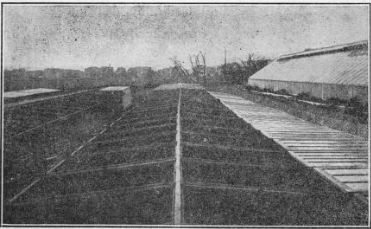161. Heating Frames By The Use Of Flues
Description
This section is from the book "Vegetable Gardening", by Ralph L. Watts. Also available from Amazon: Vegetable Gardening.
161. Heating Frames By The Use Of Flues
Many growers heat their frames by a system of flues leading from a furnace burning wood or coal. The plan is regarded as more economical than the hotbed method, and the results, with proper management, are equally satisfactory. The furnace or fire box at one end of the frame is cheaply constructed, and should be 3 or 4 feet long, and about 18 inches square, with provision for an ash pit under the grate bars. A main flue is built from the fire box, extending 8 or 10 feet under the soil of the frame, where it separates into two smaller flues that continue almost to the other end of the frame, which may be at least 60 feet long, before they join again and enter a chimney. Figure 20 shows this system of heating, but in a different form of construction. The flues may be made of brick, stone or tile, and may vary from 6 to 12 inches in size. Ten-inch tile are very satisfactory. Near the furnace the flue should be about 3 feet under the surface, rising gradually to 1 foot at the chimney. The air in the flue-heated frames has a tendency to become very dry. To prevent this, pans of water should be kept in the frames. Sheds may be built at the furnace end of the frames, to provide comfortable quarters for the work of seed sowing and transplanting.

Fig. 21. steam-heated frame.
Continue to:
- prev: 160. Other Types Of Manure Hotbeds
- Table of Contents
- next: 162. Heating With Steam And Hot Water
Tags
plants, crops, gardening, cultivated, harvesting, food ,greenhouses, fertiliser, vegitables
